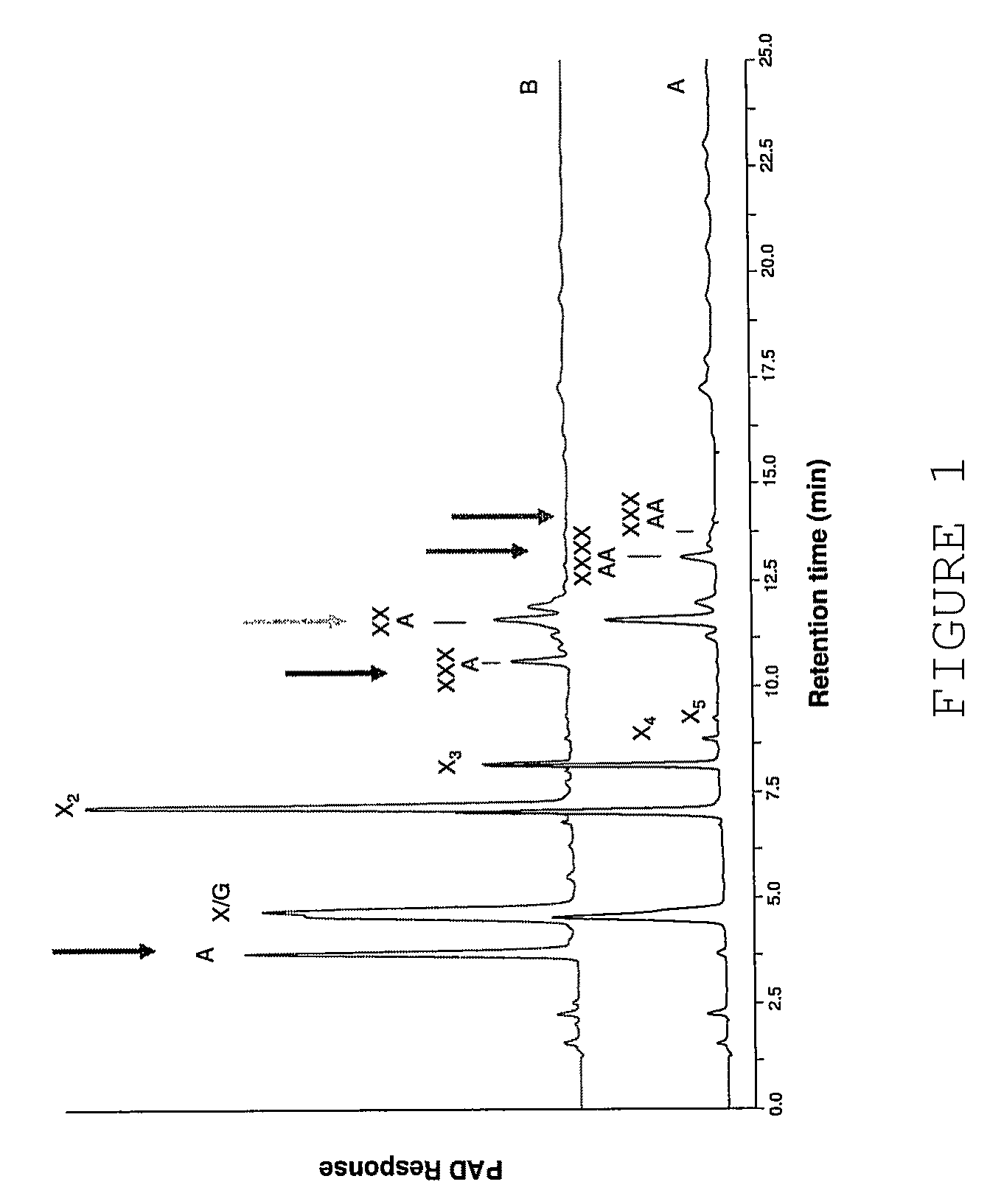BX11 enzymes having xylosidase activity
a technology of xylosidase activity and enzymes, which is applied in the field of new enzymes, can solve the problems of reducing the hydrolysis efficiency reducing the nutritional value and reducing the efficiency of hydrolysis of hemi cellulosic polymers by enzymes, so as to improve the nutritional quality of food, and improve the nutritional value of animal feed
- Summary
- Abstract
- Description
- Claims
- Application Information
AI Technical Summary
Benefits of technology
Problems solved by technology
Method used
Image
Examples
example 1
[0360]The following example illustrates the assay used to measure the •-arabinofuranosidase enzymatic activity.
[0361]This assay measured the release of p-nitrophenol by the action of α-arabinofuranosidase on p-nitrophenyl α-L-arabinofuranoside (PNPA). One α-arabinofuranosidase unit of activity is the amount of enzyme that liberates 1 micromole of p-nitrophenol in one minute at 37° C. and pH 5.0.
[0362]Acetate buffer (0.1 M, pH 5.0) was prepared as follows: 8.2 g of anhydrous sodium acetate or 13.6 g of sodium acetate*3H2O was dissolved in distilled water so that the final volume of the solution was 1000 ml (Solution A). In a separate flask, 6.0 g (5.72 ml) of glacial acetic acid was mixed with distilled water to make the total volume of 1000 ml (Solution B). The final 0.1 M acetate buffer, pH 5.0, was prepared by mixing Solution A with Solution B until the pH of the resulting solution was equal to 5.0.
[0363]PNPA (Fluka, Switzerland, cat. #73616) was used as the assay substrate. 8.25 ...
example 2
[0371]The following example illustrates the assay used to measure the ability of enzymes of the present invention to remove the •-L-arabinofuranosyl residues from double substituted xylose residues.
[0372]For the complete degradation of arabinoxylans to arabinose and xylose, several enzyme activities are needed, including endo-xylanases and arabinofuranosidases. The arabinoxylan molecule from wheat is highly substituted with arabinosyl residues. These can be substituted either to the C2 or the C3 position of the xylosyl residue (single substitution), or both to the C2 and C3 position of the xylose (double substitution). An arabinofuranosidase from Bifidobacterium adolescentis (AXHd3) has previously been isolated which was able to liberate the arabinosyl residue substituted to the C3 position of a double substituted xylose (Van Laere et al. 1997, Van den Broek et al. 2005). Most of the known arabinofuranosidases are only active towards single arabinosyl substituted xyloses.
[0373]Singl...
example 3
[0386]The following examples illustrates the assay used to measure Xyloglucanase activity. Such activity was demonstrated by using xyloglucan as substrate and a reducing sugars assay (PAHBAH) as detection method. The values were compared to a standard, which was prepared using a commercial cellulase preparation from Aspergillus niger.
Reagents
[0387]The cellulase standard solution was prepared, which contained 2 units of cellulase per ml of 0.2 M HAc / NaOH, pH 5. Subsequently, a standard series of 0 to 2 U / ml was prepared (12 samples).
[0388]Reagent A: 10 g of p-Hydroxy benzoic acid hydrazide (PAHBAH) was suspended in 60 mL water. 10 mL of concentrated hydrochloric acid was added and the volume was adjusted to 200 ml. Reagent B: 24.9 g of trisodium citrate was dissolved in 500 ml of water. To this solution 2.2 g of calcium chloride and 40 g sodium hydroxide were added. The volume was adjusted to 2 L with water. Both reagents were stored at room temperature. Working Reagent: 10 ml of Re...
PUM
| Property | Measurement | Unit |
|---|---|---|
| pH | aaaaa | aaaaa |
| pH | aaaaa | aaaaa |
| pH | aaaaa | aaaaa |
Abstract
Description
Claims
Application Information
 Login to View More
Login to View More - R&D
- Intellectual Property
- Life Sciences
- Materials
- Tech Scout
- Unparalleled Data Quality
- Higher Quality Content
- 60% Fewer Hallucinations
Browse by: Latest US Patents, China's latest patents, Technical Efficacy Thesaurus, Application Domain, Technology Topic, Popular Technical Reports.
© 2025 PatSnap. All rights reserved.Legal|Privacy policy|Modern Slavery Act Transparency Statement|Sitemap|About US| Contact US: help@patsnap.com



